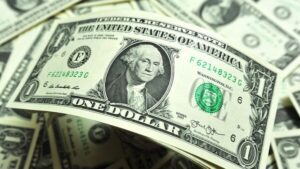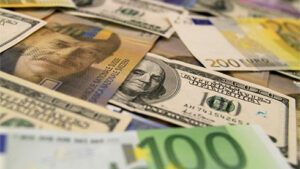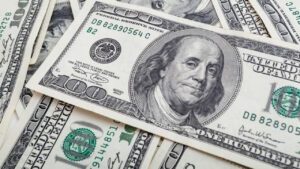
The U.S. dollar is becoming cheaper in pairs with the pound and the euro, but it is slightly stronger against the Japanese yen.
The ICE-calculated index showing the US dollar’s dynamics against six currencies (euro, Swiss franc, yen, Canadian dollar, pound sterling and the Swedish krona) is down less than 0.1% in the morning session.
The euro/dollar pair is trading at $1.0599 as of 8:18 a.m. versus $1.0587 at the close of Tuesday’s session, with the euro adding about 0.2%.
Investors continue to evaluate statistical data and statements by Federal Reserve (Fed) officials to try to predict future interest rate changes.
Judging by the rate futures, market participants see some probability that at the next meeting of the Federal Reserve the rate will be increased by 50 basis points at once, though earlier investors were sure that the central bank will now change the rate in steps of 25 bps.
Overall, the market is expecting a rate hike to peak at 5.25-5.5% from the current 4.5-4.75%.
The pound is up 0.2% at $1.2049 versus $1.2023 at the close of last session.
The dollar is up 0.1% against the yen, trading at 136.37 yen.
Meanwhile, the yuan, which is traded in mainland China, jumped against the dollar by 0.4% to 6.9035/$1.
As reported, Purchasing Managers Index (PMI) in the processing industry in China rose to 52.6 points in February from 50.1 points a month earlier. Experts on average had expected a more moderate increase to 50.5 points.
The service sector PMI rose to 56.3 points in February from 54.4 points in January. The indicator reached its highest level since March 2021.
The index value above the mark of 50 points indicates an increase in business activity, below it – a decrease.

The U.S. dollar is strengthening against the euro, the yen and the pound sterling in trading on Tuesday amid market revisions of expectations for the Federal Reserve (Fed) rate peak.
The ICE-calculated index showing the dollar’s performance against six currencies (euro, Swiss franc, yen, Canadian dollar, pound sterling and Swedish krona) added 0.17% in trading, while the broader WSJ Dollar Index gained 0.16%.
The euro/dollar pair is trading at $1.0585 as of 8:15 a.m., up from $1.0611 at Monday’s market close.
The pound exchange rate had dropped to $1.2041 by that time from $1.2065 the day before.
The value of the American currency against the yen is 136.31 yen against 136.23 yen at the end of the previous session.
The futures market expects the Fed’s rate to peak at 5.4% this year, although a month ago the maximum rate was estimated at 5%, Bloomberg noted.
The adjustment of traders’ expectations is related to signals of the sustainability of inflation in the U.S. According to the data published on Friday, the consumer price index (PCE index) in the states in January increased by 0.6% against the previous month (the maximum increase for six months), and in annual terms it rose by 5.4%. The rate of growth accelerated compared to December, when it was 0.2% and 5.3%, respectively.
Statistical data from the euro zone, to be released Thursday, are expected to show some easing of inflation in the region in February. The consensus analyst forecast cited by Trading Economics expects the euro area’s consumer price growth rate to slow to 8.2% on an annualized basis this month from 8.6% in January.
However, the rate of consumer price growth excluding food and energy (CPI Core, a core inflation indicator) is expected to remain at 5.3%, a record high.
The swap market expects the ECB deposit rate, currently at 2.5%, to rise to 3.9% in February 2024.

The ICE-calculated index showing the dollar’s dynamics against six currencies (euro, Swiss franc, yen, Canadian dollar, pound and Swedish krone) is losing 0.03% in trading, while the broader WSJ Dollar Index is stable.
The minutes of Wednesday’s Jan. 31-Feb. 1 U.S. Central Bank meeting showed that Fed policymakers plan to continue raising rates, believing that current levels are not enough to curb economic activity to beat inflation. At the same time, they believe that the cycle of rate hikes could be completed this year.
According to the minutes, meeting participants also noted that the restrictive policy will need to be maintained until the Central Bank has “confidence that inflation is on the path to a steady decline to the 2% level.”
Eurozone inflation stats released Thursday confirmed investors’ view that the European Central Bank will continue to tighten policy sharply.
According to final data from the European Union Statistical Office (Eurostat), consumer prices excluding food and energy (CPI Core Index, an indicator of core inflation) rose at a record annual rate of 5.3% in January. They had been previously reported to have risen 5.2% in January, and analysts did not expect the data to be revised.
The estimate for consumer price growth as a whole was revised to 8.6% annualized from the previously announced 8.5%, Eurostat said.
The euro/dollar pair was trading at $1.0603 as of 8:15 a.m., up from $1.0596 at market close on Thursday.
The pound is at $1.2023 from $1.2013 the day before.
The U.S. currency fell to 134.58 yen against 134.68 yen in trading during the previous session.
Kazuo Ueda, who was nominated as the head of the central bank by the Japanese government said during his speech in the parliament on Friday that he considered it reasonable to keep ultra soft monetary policy in Japan in order to achieve the central bank’s inflation target. At the same time, he made it clear that he sees various options for controlling the yield curve of government bonds in the future.

The US dollar is getting stronger against the euro, the yen and the pound sterling during trading on Tuesday.
Traders are awaiting the publication of the Federal Reserve System (Fed) meeting minutes from January 31 to February 1. The Federal Reserve Board decided to raise the rate by 25 basis points (bps) – to 4.5-4.75% a year.
Experts expect that the protocol may confirm the Fed’s intention to continue raising the rate longer than it was planned before, Trading Economics said.
The latest statistical data on the U.S. economy has “called into question” arguments that the Fed may soon halt its rate hike cycle or move to lower rates altogether, notes Chuck Camello, president and chief executive officer of Essex Financial Services.
“I think the market is finally coming to the realization that U.S. rates will be higher than expected, and longer than expected,” Bloomberg quoted the expert as saying.
Calculated by ICE index showing dollar dynamics against six currencies (euro, Swiss franc, yen, Canadian dollar, pound sterling and Swedish krona) added 0.13% during Tuesday’s trading, broader WSJ Dollar Index added 0.15%.
The euro/dollar pair is trading at $1.0672 as of 8:10 a.m., up from $1.0687 at Monday’s market close.
The pound fell to $1.2026 from $1.2041 the day before.
The value of the American currency against the yen rose to 134.39 yen against 134.26 yen in previous trading.

The U.S. dollar goes up against the euro, yen and pound sterling in trading on Friday on hawkish statements of Federal Reserve (Fed) executives, which strengthened traders’ opinion that the U.S. Central Bank is not going to stop the rate hike cycle yet.
Federal Reserve Bank (FRB) Cleveland President Loretta Mester said the day before that she had seen a “compelling case” for a 50 basis points (bps) rate hike at the January 31-February 1 Fed meeting.
The Federal Open Market Committee (FOMC) unanimously decided at that meeting to raise the rate by 25 bps, to 4.5-4.75% per year.
Mester still believes the Fed needs to raise the benchmark rate to more than 5% and keep it above that mark for a while to get inflation back under control.
St. Louis Fed Chairman James Ballard said Thursday that, like Mester, he supported a 50-bp rate hike at the last meeting. Neither Ballard nor Mester have a vote on the FOMC this year.
Ballard said he thinks the Fed should raise the rate to 5.25-5.5% and do it “as soon as possible. Thus, Ballard believes it is necessary to raise the rate by 75 bps from current levels, Market Watch notes.
“A further rate hike could help solidify the disinflationary trend in 2023 even as the economy continues to grow and the labor market is strong,” Ballard said.
The ICE-calculated index, which shows the dollar’s performance against six currencies (euro, Swiss franc, yen, Canadian dollar, pound sterling and Swedish krona), added 0.53% Friday, while the broader WSJ Dollar Index gained 0.38%.
The euro/dollar pair was trading at $1.0638 as of 7:45 a.m., compared with $1.0672 at market close Thursday.
The pound was down to $1.1948 from $1.1988 the day before.
The value of the American currency against the yen rose to 134.71 yen against 133.94 yen by the previous trading results.
The dollar/yuan pair is trading at 6.8755 yuan, compared to 6.8607 yuan on the previous day.
EURO, pound, U.S. dollar, yen

The U.S. dollar is strengthening against the euro, the yen and the pound sterling in trading on Friday.
The ICE-calculated index showing the dollar’s dynamics against six currencies (euro, Swiss franc, yen, Canadian dollar, pound sterling and Swedish krona) is adding 0.16%, while the broader WSJ Dollar Index is up 0.18%.
The euro/dollar pair is trading at $1.0722 as of 7:50 a.m., up from $1.0743 at the close of the previous session.
The pound is at $1.2097, compared to $1.2121 the day before.
The dollar went up to 131.74 yen against 131.54 yen at the close of trading on Thursday.
Signals that the Federal Reserve (Fed) may raise the benchmark interest rate higher than the market expects provided support for the American currency. Several Fed policymakers this week signaled they believe a further rate hike is necessary because the fight against high inflation has not yet been won and there is no significant slowdown in economic growth.
Next week, the January U.S. inflation data will be released. The consensus forecast from experts cited by Trading Economics suggests consumer prices are up 0.5% from December, when they fell 0.1%.
The Australian dollar fell in trading Friday to $0.6924 from $0.6937.
The Reserve Bank of Australia (RBA) raised its forecast for core inflation, which excludes food and energy costs, for the current fiscal year ending in June to 6.25% from 5.5%.